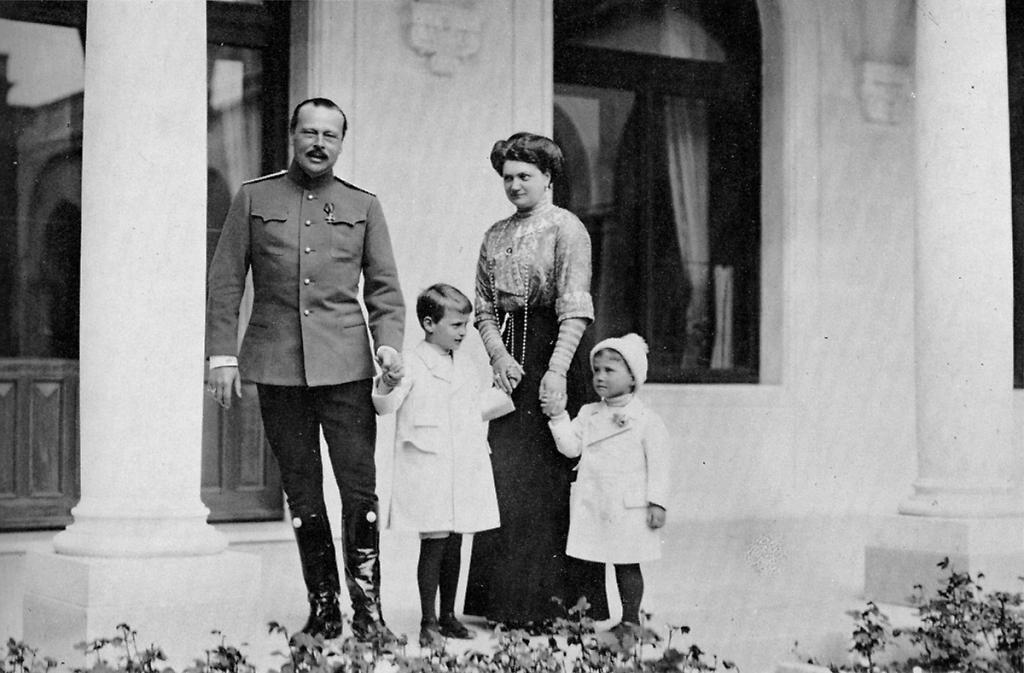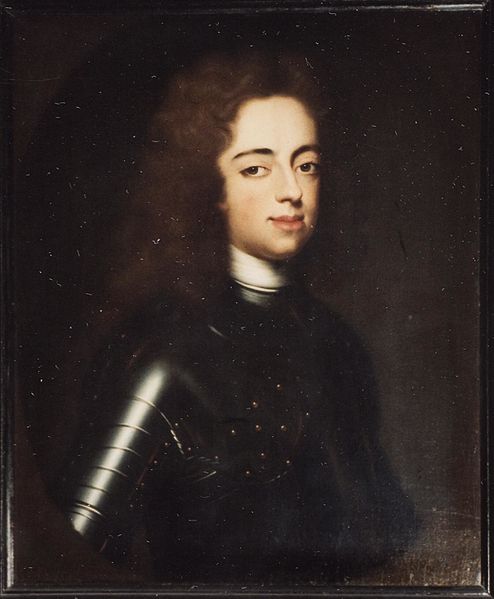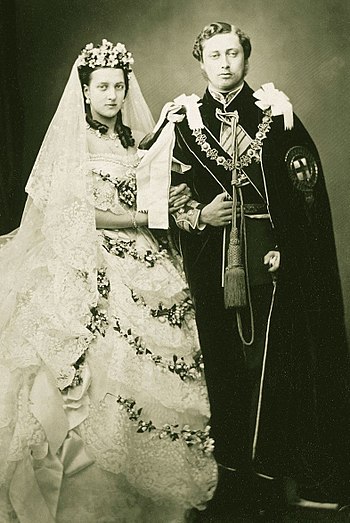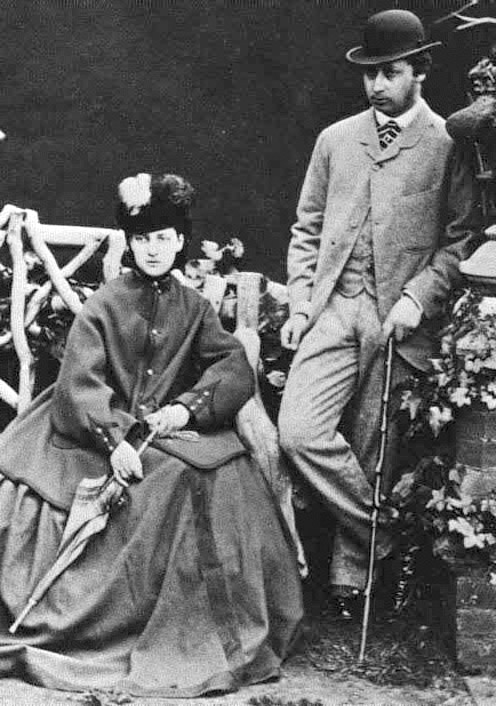compiled by Susan Flantzer

Queen Victoria and Prince Albert with their nine children; Photo Credit – Wikipedia
Queen Victoria and Prince Albert have 140 great-great-grandchildren. Great-great-grandchildren are third cousins. Note that many of the great-great-grandchildren used or are using styles and titles from monarchies that ceased to exist during the 20th century. The great-great-grandchildren are arranged according to their relationship with Queen Victoria’s children. Death dates may be updated only for notable people. The links below are for Unofficial Royalty articles or Wikipedia articles. Not all great-great-grandchildren have articles.
Other Queen Victoria resources here at Unofficial Royalty:
- House of Hanover: Queen Victoria Index
- Queen Victoria’s Children and Grandchildren
- Queen Victoria’s Great-Grandchildren
- Queen Victoria’s Saxe-Coburg Relatives
- Hemophilia in Queen Victoria’s Family
- December 14 – Queen Victoria’s Dire Day
Notable Great-Great-Grandchildren
- Queen Elizabeth II of the United Kingdom
- Prince Philip, Duke of Edinburgh (born Prince Philip of Greece and Denmark)
- King Harald V of Norway
- King Carl XVI Gustaf of Sweden
- Queen Margrethe II of Denmark
- King Juan Carlos I of Spain
- Queen Sofia of Spain (born Princess Sophia of Greece and Denmark)
- King Constantine II of Greece
- Queen Anne-Marie of Greece (born Princess Anne-Marie of Denmark)
- King Michael I of Romania
GREAT-GRANDCHILDREN OF VICTORIA, PRINCESS ROYAL, GERMAN EMPRESS, QUEEN OF PRUSSIA
- Prince Wilhelm of Prussia (1906 – 1940)
- Prince Louis Ferdinand of Prussia (1907 – 1994)
- Prince Hubertus of Prussia (1909 – 1950)
- Prince Friedrich of Prussia (1911 – 1966)
- Princess Alexandrine of Prussia (1915 – 1980)
- Princess Cecilie of Prussia (1917 – 1975)
- Princess Victoria Marina of Prussia (1917 – 1981)
- Prince Wilhelm-Victor of Prussia (1919 – 1989)
- Prince Alexander Ferdinand of Prussia (1912 – 1985)
- Prince Oskar of Prussia (1915 – 1939)
- Prince Burchard of Prussia (1917 – 1988)
- Princess Herzeleide of Prussia (1918 – 1989)
- Prince Wilhelm-Karl of Prussia (1922 – 2007)
- Prince Karl Franz Joseph of Prussia (1916 – 1975)
- Ernst August IV, Hereditary Prince of Brunswick, Prince of Hanover (1914 – 1987)
- Prince Georg Wilhelm of Hanover (1915 – 2006)
- Princess Friederike of Hanover, Queen of Greece (1917 – 1981)
- Prince Christian Oskar of Hanover (1919 – 1981)
- Prince Welf Heinrich of Hanover (1923 – 1997)
- Princess Barbara of Prussia (1920 – 1994)
- Prince Alfred of Prussia (1924 – 2013)
- Princess Alexandra of Greece and Denmark, Queen of Yugoslavia (1921 – 1993)
- Princess Sophie of Greece and Denmark, Queen Sofia of Spain (1938 – )
- King Constantine II of Greece (1940 – 2023)
- Princess Irene of Greece and Denmark (1942 – )
- Prince Amedeo III of Savoy, 5th Duke of Aosta (1943 – 2021)
- Richard Paul Brandram (1948 – 2020)
- Landgrave Moritz of Hesse-Kassel (1926 – 2013)
- Prince Heinrich of Hesse-Kassel (1927 – 1999)
- Prince Otto of Hesse-Kassel (1937 – 1998)
- Princess Elisabeth of Hesse-Kassel (1940 – )
- Princess Christina of Hesse-Kassel (1933 – 2011)
- Princess Dorothea of Hesse-Kassel (1934 – )
- Prince Karl of Hesse-Kassel (1937 – 2022)
- Prince Rainer of Hesse-Kassel (1939 – )
- Princess Clarissa of Hesse-Kassel (1944 – )
GREAT-GRANDCHILDREN OF KING EDWARD VII OF THE UNITED KINGDOM
- Queen Elizabeth II of the United Kingdom (1926 – 2022)
- Princess Margaret of the United Kingdom, Countess of Snowdon (1930 – 2002)
- George Lascelles, 7th Earl of Harewood (1923 – 2011)
- The Honorable Gerald Lascelles (1924 – 1998)
- Prince William of Gloucester (1941 – 1972)
- Prince Richard, Duke of Gloucester (1944 – )
- Prince Edward, Duke of Kent (1935 – )
- Princess Alexandra of Kent (1936 – )
- Prince Michael of Kent (1942 – )
- James Carnegie, 3rd Duke of Fife (1929 – 2015)
- Princess Ragnhild of Norway (1930 – 2012)
- Princess Astrid of Norway (1932 – )
- King Harald V of Norway (1937 – )
GREAT-GRANDCHILDREN OF PRINCESS ALICE OF THE UNITED KINGDOM, GRAND DUCHESS OF HESSE AND BY RHINE
- Princess Margarita of Greece and Denmark (1905 – 1981)
- Princess Theodora of Greece and Denmark (1906 – 1969)
- Princess Cecilie of Greece and Denmark (1911 – 1937)
- Princess Sophie of Greece and Denmark (1914 – 2001)
- Prince Philip of Greece and Denmark, Duke of Edinburgh (1921 – 2021)
- Lady Tatiana Elizabeth Mountbatten (1917 – 1988)
- David Mountbatten, 3rd Marquess of Milford Haven (1919 – 1970)
- Patricia Mountbatten, 2nd Countess Mountbatten of Burma (1924 – 2017)
- Lady Pamela Mountbatten Hicks (1929 – )
- Prince Ludwig of Hesse and by Rhine (1931 – 1937)
- Prince Alexander of Hesse and by Rhine (1933 – 1937)
- Princess Johanna of Hesse and by Rhine (1936 – 1939)
GREAT-GRANDCHILDREN OF PRINCE ALFRED, DUKE OF EDINBURGH, DUKE OF SAXE-COBURG AND GOTHA
- Mircea Carol Hohenzollern (1920 – 2006)
- King Michael I of Romania (1921 – 2017)
- King Peter II of Yugoslavia (1923 – 1970)
- Prince Tomislav of Yugoslavia (1928 – 2000)
- Prince Andrej of Yugoslavia (1929 – 1990)
- Archduke Stefan of Austria-Tuscany (1932 – 1998)
- Archduchess Marie Ileana of Austria-Tuscany (1933 – 1959)
- Archduchess Alexandra of Austria-Tuscany (1935 – )
- Archduke Dominic of Austria-Tuscany (1937 – )
- Archduchess Maria Magdalena of Austria-Tuscany (1939 – 2021 )
- Archduchess Elizabeth of Austria-Tuscany (1942 – 2019)
- Prince Emich of Leiningen, 7th Prince of Leiningen (1926 – 1991)
- Prince Karl of Leiningen (1928 – 1990)
- Princess Kira Melita of Leiningen (1930 – 2005)
- Princess Margarita of Leiningen (1932 – 1996)
- Princess Mechtilde of Leiningen (1936 – )
- Prince Friedrich Wilhelm of Leiningen (1938 – 1998)
- Prince Peter Viktor of Leiningen (1942 – 1943)
- Grand Duchess Marie Vladimirovna of Russia (1953 – )
- Prince Kraft of Hohenlohe-Langenburg, 9th Prince of Hohenlohe-Langenburg (1935 – 2004)
- Princess Beatrix of Hohenlohe-Langenburg (1936 – 1997)
- Hereditary Prince Georg Andreas of Hohenlohe-Langenburg (1938 – 2021)
- Prince Ruprecht of Hohenlohe-Langenburg (1944 – 1978)
- Prince Albrecht of Hohenlohe-Langenburg (1944 – 1992)
- Hereditary Prince Hans Albrecht of Schleswig-Holstein-Sonderburg-Glücksburg (1917 – 1944)
- Prince Wilhelm Alfred of Schleswig-Holstein-Sonderburg-Glücksburg (1919 – 1926)
- Duke Peter of Schleswig-Holstein-Sonderburg-Glücksburg (1922 – 1980)
- Princess Marie Alexandra of Schleswig-Holstein-Sonderburg-Glücksburg (1927 – 2000)
- Princess Gerarda de Orleans-Borbon y Parodi-Delfino (1939 – )
- Prince Alonso de Orleans-Borbon y Parodi-Delfino (1941 – 1975)
- Princess Beatriz de Orleans-Borbon y Parodi-Delfino (1943 – )
- Prince Alvaro-Jaime de Orleans-Borbon y Parodi-Delfino (1947 – )
GREAT-GRANDCHILDREN OF PRINCE ARTHUR, DUKE OF CONNAUGHT
*Also great-grandchildren of Prince Leopold, Duke of Albany via their mother.
- *Princess Margaretha of Sweden (1934 – )
- *Princess Birgitta of Sweden (1937 – )
- *Princess Désirée of Sweden (1938 – )
- *Princess Christina of Sweden (1943 – )
- *King Carl XVI Gustaf of Sweden (1946 – )
- Count Michael Bernadotte of Wisborg (1944 – )
- Queen Margrethe II of Denmark (1940 – )
- Princess Benedikte of Denmark (1944 – )
- Princess Anne-Marie of Denmark, Queen Anne-Marie of Greece (1946 – )
- Katharine Fraser, Mistress of Saltoun (1957 – )
- Alice Ramsay (1961 – )
- Elizabeth Ramsay (1963 – )
GREAT-GRANDCHILDREN OF PRINCE LEOPOLD, DUKE OF ALBANY
- Anne Abel Smith (1932 – )
- Richard Abel Smith (1933 – 2004)
- Elizabeth Abel Smith (1936 – )
- Princess Caroline Mathilde of Saxe-Coburg and Gotha (1933 – )
- Prince Ernst Leopold of Saxe-Coburg and Gotha (1935 – 1996)
- Prince Peter of Saxe-Coburg and Gotha (1939 – )
- **Princess Margaretha of Sweden (1934 – )
- **Princess Birgitta of Sweden (1937 – )
- **Princess Désirée of Sweden (1938 – )
- **Princess Christina of Sweden (1943 – )
- **King Carl XVI Gustaf of Sweden (1946 – )
- Count Bertram of Castell-Rüdenhausen (1932 – )
- Count Conradin of Castell-Rüdenhausen (1933 – 2011)
- Countess Victoria of Castell-Rüdenhausen (1935 – )
- Calma Schnirring (1938 – )
- Dagmar Schnirring (1940 – )
- Michael Schnirring (1943 – 1966)
- Prince Andreas of Saxe-Coburg and Gotha (1943 – )
- Princess Claudia of Saxe-Coburg and Gotha (1949 – 2016)
- Princess Beatrice of Saxe-Coburg and Gotha (1951 – )
- Prince Adrian of Saxe-Coburg and Gotha (1955 – 2011)
**Also great-grandchildren of Prince Arthur, Duke of Connaught via their father.
GREAT-GRANDCHILDREN OF PRINCESS BEATRICE OF THE UNITED KINGDOM, PRINCESS HENRY OF BATTENBURG)
- Robin Alexander Bryan (1957 – )
- Alfonso de Borbon y de Dampierre, Duke of Anjou and Cadiz (1936 – 1989)
- Gonzalo de Borbon y de Dampierre, Duke of Aquitaine (1937 – 2000)
- Princess Alessandra Torlonia of Civitella-Cesi (1936 – 2014)
- Marco Alfonso Torlonia, 6th Prince of Civitella-Cesi (1937 – 2014)
- Prince Marino Torlonia of Civitella-Cesi (1939 – 1995)
- Princess Olimpia Torlonia of Civitella-Cesi (1943 – )
- Vittoria Marone-Cinzano (1941 – )
- Giovanna Marone-Cinzano (1943 – )
- Maria Teresa Marone-Cinzano (1945 – )
- Anna Marone-Cinzano (1948 – )
- Infanta Pilar of Spain, Duchess of Badajoz (1936 – 2020)
- King Juan Carlos I of Spain (1938 – )
- Infanta Margarita of Spain, Duchess of Soria (1939 – )
- Infante Alfonso of Spain (1941 – 1956)



























































